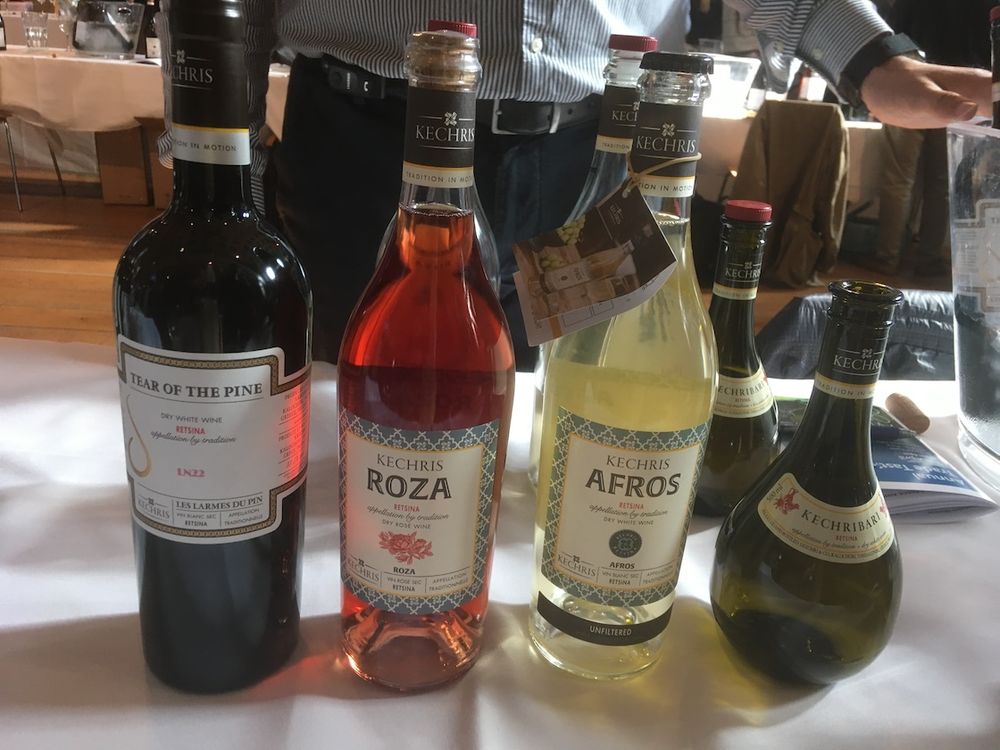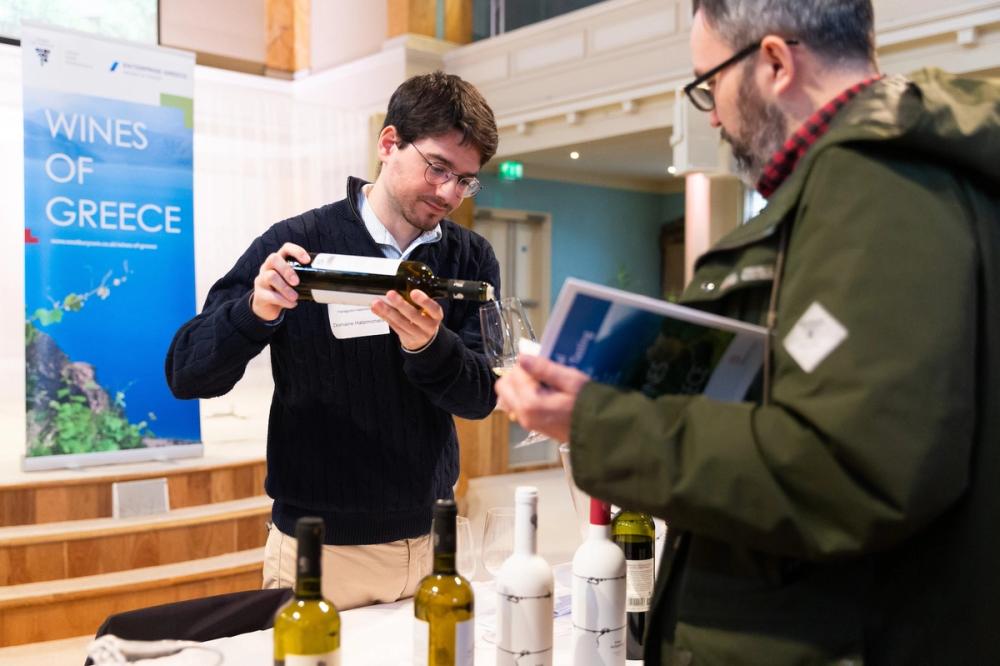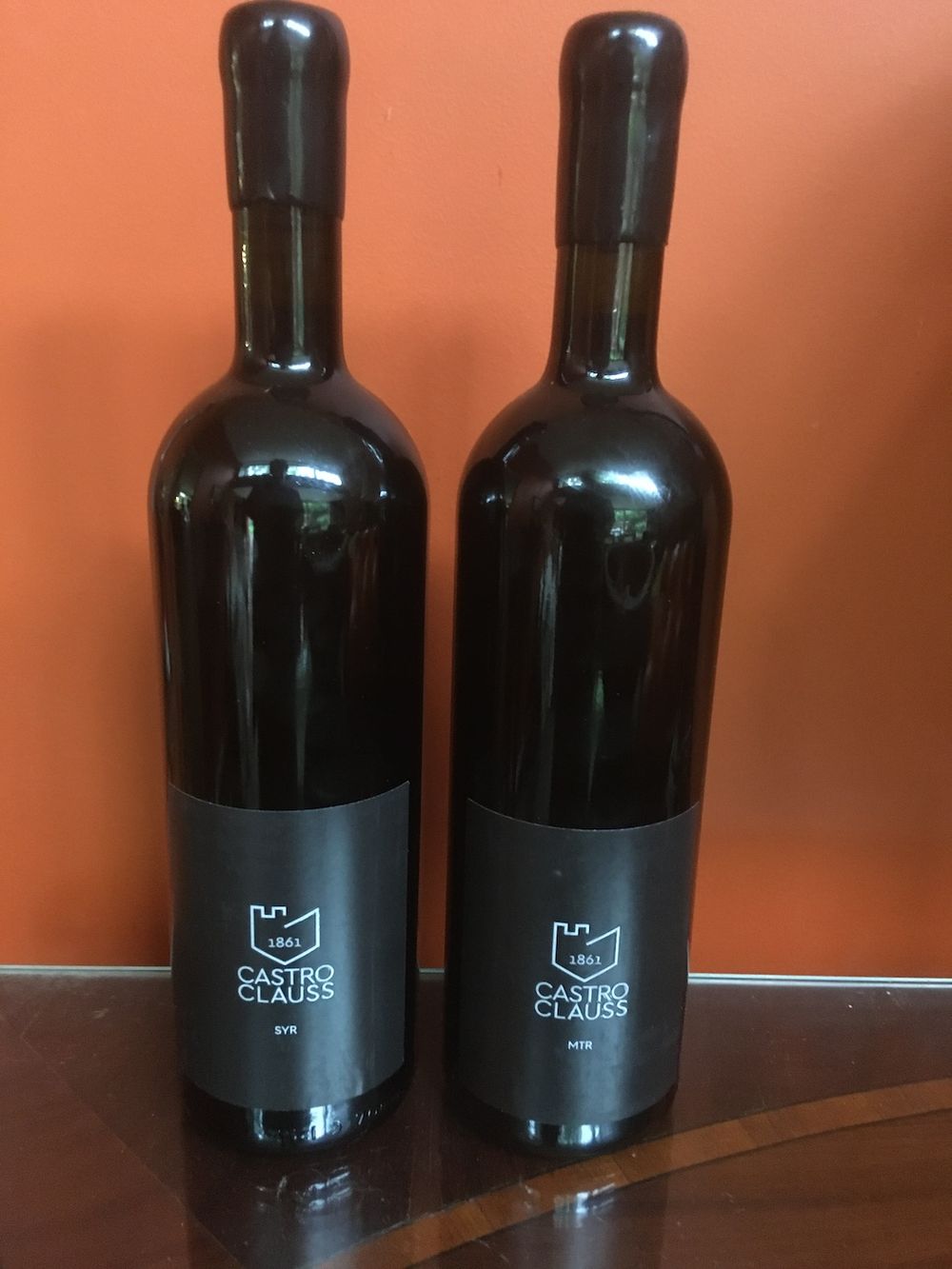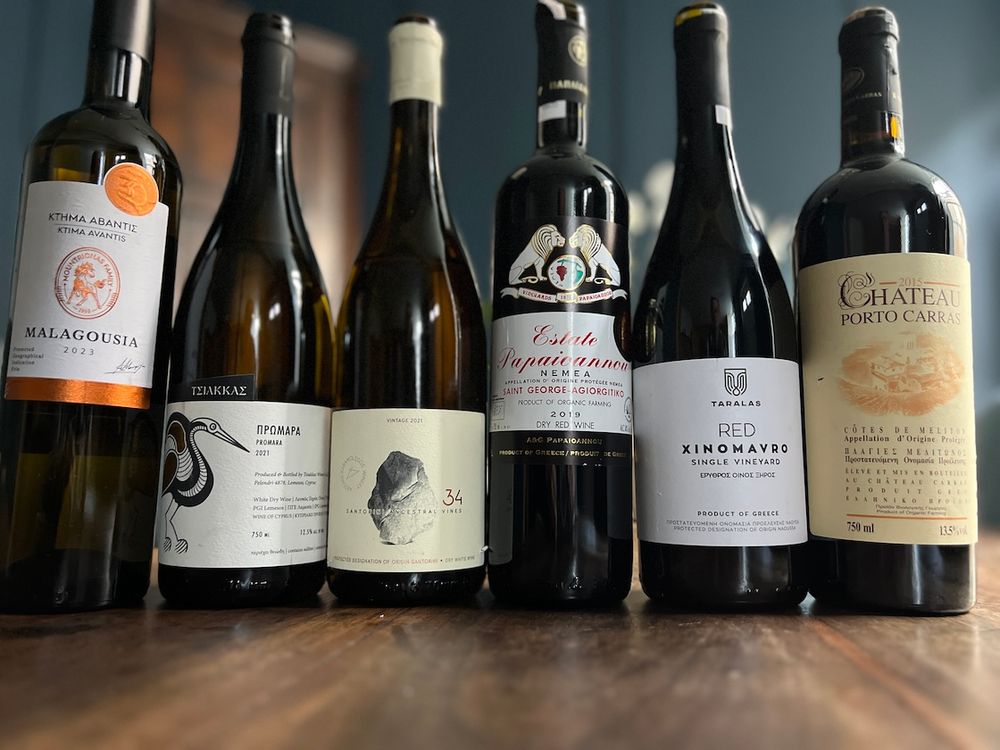I got the venue for this year’s Wines of Greece tasting completely wrong - I was convinced it was at the St John’s Church opposite Waterloo Station, like last year, and stumbled on a celestial choir practice rather than a more corporeal wine tasting. When I twigged the event was at another place of worship-turned tasting venue, the bigger St Mary’s Church, Marylebone, I saw why - with almost 50 producers and hundreds of wines from across the mainland and islands, this was probably the UK’s largest ever showing of Greek wine. Hallelujah to that, whichever church you’re in.
“It’s really impressive to see such a range of Greek wines in one place in the UK,” said Steve Daniel of Hallgarten & Novum Wines, who set the current vogue for Greek wine into play by building up the largest range here over the last decade or so.

Impressive to see such a range of Greek wines in one place
Others have followed suit including Enotria & Coe, Indigo Wines, Flint Wines, alongside the likes of Maltby and Greek, Amathus and Southern Wines Roads, who focus on smaller, more niche producers often working with scarce, esoteric varieties (Methymnaeos on Lesbos, imported by Southern Wine Roads, who make white, red and orange wines from a single variety - Chidiriotiko - is a fine example). All of these importers were present, showing agencies from across the Greek mainland and islands, with Santorini and Crete unsurprisingly perhaps, the most prominent.
But they are clearly the tip of the iceberg. Seven of the producers here were without representation in the UK market, which is quite remarkable given that some of their wines were amongst the most interesting in the tasting, showing varieties which - even to a geek like me - were quite unfamiliar.
So where to start?

The wines chosen for the Wines of Greece masterclass
Kechris Winery, based in Macedonia, makes a great, surprisingly full-bodied Xinomavro but what stands out here are the retsinas, quite unlike any I have tasted before. The range is extensive and eclectic, underwritten by the Kechribari Retsina, familiar across Greece and a great Roditis-based Retsina.
“We make typically around two million bottles of this a year and its success allows us to experiment and show the true potential of retsina,” says Tasos Nikoleiri, who works with his own rather than bought-in pine resin.
Indeed, if you think retsina is a simple beach wine, not to be tasted away from a simple taverna, think again. Of Kechris’ range, the two most enjoyable wines were the retsinas made from Xinomavro - the pink, understated but delicious Roza 2022 - and Tears of the Pine 2022, made from 100% Assyrtiko. Both 13.5% and likely to change your impression of retsina forever.

Also from Macedonia, Noema Winery (unsurprisingly perhaps for this region) is a specialist in Xinomavro, often described as Greece’s answer to Nebbiolo. Its Blanc de Noirs Xinomavro 2022 is an impressive take on what can be a difficult style - even the great Thymiopolous, who has launched a Xinomavro white into the UK via Majestic, struggles.
Noema, however, manages to calm the tough acidity which could easily overwhelm this white wine: there are nice floral notes here, with suggestions of melon and green apple on the palate and the wine opens up nicely after several minutes in the glass. This young winery making just 25,000 bottles close by the Albanian border is only two years old but clearly has a great future.

Greek wine's progression: traditional wines with a long history now re-envisioned by pioneering producers. This is symbolic of how Greek wine is progressing.
From Drama in Macedonia up near the border with Bulgaria, Wine Art Estate – which last year celebrated its 30th anniversary – is one of the great unsung heroes of Greece’s modern wine revolution. Now producing 300,000 bottles it has a number of ranges starting with the entry level Techni Aliapas – mainly blends – going up through the Plano range to the impressive Idisma Drios wines, which the producer was showing at the tasting. I really enjoyed the simple but very well-made Plano Malagousia 2023, a great iteration of the variety with rounded peachy and apricot tones on the palate supported by vibrant acidity, but everything in balance.
The three Idisma Drios wines (which sell in Greece for between £20-30 a bottle) are simply great: Anafora Limniona 2020 is a lovely rounded but fresh example
of this relatively scarce late ripening red variety, often compared to Spain’s Mencia grape and here showing as a medium bodied, red cherry-styled wine, given greater complexity by elevation.
The Idismas Drios Assrytiko 2022 is just at the start of what will be a long life, with racy saline acidity but good fruit too, and a long finish: very different from a Santorini Assyrtiko of course, but one of the best Macedonian takes on the variety I have tried.
The Idismas Drios Xinomavro 2019 or Xi, checking in at 14.5% abv, is a wonderfully rich, full bodied take on the variety, showing powerful, moody dark fruit but good restraint and acidity. Not so sure Xi is a good name to run with, particularly for drinkers of a more liberal sensibility (!) but this is a lovely take on the variety, with floral notes supporting the underlying spicy character.

Jima Winery based in Epirus, western Greece is even more of a boutique operation, run by two winemakers who are working with indigenous and international varieties. Jima stresses its calcareous/ clay soils and its location near the Albracian Gulf, a national park located in western Greece around one hour from Ioannina, Epirus’s main town and the summer holiday destination of Parga.
Of the two wines I tried Odyssey 2022 is a good solid blend of Merlot and Cabernet Franc, full-on fruit and 14% alcohol and a perfect accompaniment to steak. More interesting is the Jack of Spades 2022, made with 100% Vlahico, a rare late ripening red variety local to the region. This wine has a beautiful label suggesting an Impressionist painting, and the wine has suggestions of dark berries and fresh local herbs on the palate; medium weight, just 12.5% but lots of flavour and great length.

Viticulturally vast: Greece has 33 PDOs and over 100 PGIs
And then three producers from the Peloponnese, the largest wine region in Greece.
At first glance, you wonder whether Antonopoulos Vineyards, based in Achaia, are actually that interested in exporting at all seeing that their labels, do not have a single word in Roman lettering, which calls to mind that old phrase “it’s all Greek to me.” Their wines, however, really do deserve a wider audience.
This high-altitude producer started up in 1987 but lost its eponymous founder who died just seven years later in 1994; today it makes around 400,000 bottles of mostly high quality wine. In this region red Agiorgitiko and white/pink Moscofilero are king, but these guys are focused on the less familiar, with a focus on high altitude viticulture.
The reds are great – a deep, dark, tannic Indigenous Variety Collection 2022 Vertzami, highlighting a western Greece variety praised by Konstantinos Lazarakis MW as a rising star that we should all be watching out for. Quite delicious, I must say, made from grapes grown on the island of Lefkada, full on with flavour and an intense, dark almost black colour reflecting barrel and bottle ageing.
For reasons entirely unclear Graham Hill’s moustachioed visage against a backdrop of racing cars decorates the label of the delicious, full-bodied Morfeas 2020 made from 100% Mavrodaphne – puzzling I admit but not enough to put me off this amazingly deep and well-structured wine, 15.5% abv and in many ways reminiscent of the more modern, carefully oaked Amarones now coming out of Veneto. This wine is only made in the best years and is regarded as one of the most iconic wines of Greece – well worth trying, with dark bramble berries, cherry and plum on a very long and seductive palate.
By contrast, the Indigenous Variety Collection Skiadopoulou 2019 is a more muted affair, a balanced lightly floral white with suggestions of marzipan and apricot. A great aperitif wine and fun to get your mates to pronounce properly (skier-dop-oo-loo, I believe, is the way to go but I won’t bet my house on it. Again, this is a variety we will see more of as producers look to resurrect varieties once deemed uneconomic.

Castro Clauss – which shares familial links with Antonopoulos Vineyards -owes its lineage to Achaia Clauss, established in the Patras in the immediate post war years and in the 1970s and 1980s was the dominant force in Greek wine with the bestselling Demestica brand (“kills all known germs dead” we used to joke).
Castro Clauss today is a very different animal, with an entry level range (which wasn’t being shown) and a high end, tiny volume premium range, which was. Castro Clauss has abbreviated the name of the variety in each of these wines, so ROW 2022 is Rodities, CHR 2022 Chardonnay, whilst MTR 2020 is (Mavrodaphne) and SYR 2020 (Syrah). The last two are highly accomplished, full-on wines – the MTR fruit-driven, forceful and 16% abv – not a shy wine by any means but showing great expression of this famous black grape, whilst the SYR at 15% is also weighty, very berry and dark cherry charged, with a long finish. These are very high-end wines, it is true, but also very memorable.
Located close by the site of Ancient Nemea, the boutique Palivou Estate produces a range of wines from Assyrtiko, Malagousia and Kydonitsa amongst others but, being based where it is, the focus white-wise is on Moschofilero and with reds, on Agiorgitiko.
Top of the class amongst the latter is the Ammos Terra Leone 2021, at 15% abv a full- on juicy and fruity take on the variety, not subtle but showing some complexity and age-worthiness, as does the more restrained, but also more tannic Ktima Palivou Nemea 2021: aged in barrel for a year, this shows chocolate, red cherry and liquorice on the palate and has decent length.
For me, though, the star here is the Kydonitsa 2023, made from organic grapes grown on the limestone and clay soils of the Diaselo vineyard. A very rare white variety with huge potential, just 4500 bottles of this were produced. Really expressive, quite floral with suggestions of peach and apricot on the palate and great complexity – comparable to me at least, to a fine Viognier. Apparently more plantings of this ancient, but long neglected, variety are now being made which is great news, because to me it has the same sort of potential as Malagousia, another variety bought back from the dead by Ktima Gerovassiliou around 20 years ago.

Richard Bampfield MW addresses the masterclass
Although Greece accounts for just 1% of global wine production, interest - particularly in the on-trade - has never been higher with consumers appreciating the varieties and firm sense of provenance. Even supermarkets are getting in on the act with M&S, Aldi and more recently Lidl adding Greek wines to their lists at under £10 a bottle.
Given that many leading importers here have yet to list a Greek agency, there’s clearly lots of scope for these producers to find a UK representative. And frankly they really should – I’ve never tasted a more intriguing bunch of exciting and expressive wines, at prices to suit all budgets. Yamas, as the Greeks would say.
And finally ….
Peter Dean turns the spotlight on six wines from Amathus that caught his attention

Avantis Estate Malagousia 2023
Dry, complex gastronomic white from one of the more progressive wineries on the island of Evia. On the nose you find lifted aromatics of honeysuckle, rose petals, Mediterranean herbs, mandarin; in the mouth the wine is fresh and tangy with lime, peach, good weight in the mid-palate, zesty finish. 13% abv
Tsiakkas Promara White 2021
100% Promara from the Limassol region of Cyprus – a long forgotten grape indigenous to Cyprus which is the first grape to ripen on the island. The wines comes from 5 hectares of ungrafted phylloxera-free vines from steep, high slopes. Green apples, preserved lemon, apricot and almond notes; in the mouth the wine is fresh, rounded, decent weight (from nine months on the lees), flavours of honeydew melon, stone fruits and a hint of acacia. 12.5% abv
Artemis Karamolegos 34, 2021
Broad and powerful style of Assyrtiko from 120 year old vines at one of Santorini’s oldest wineries. The nose has an intriguing mix of wild herbs near the sea, citrus. The wine has a mouth-filling palate, fresh but broad and ripe on account of time spent on lees and 10% in oak. You pick up citrus zest, beeswax, quince. On the finish you get a real sense of its powerful mineral core. 14% abv
Papaioannou Nemea, 2019
From the Greek wine region of Nemea in the Peloponnese this is a complex blended red, majoring in indigenous Agiorgitiko grapes. Deep ruby, the aromatics are alluring with plum and black fruits, nuances of dried herbs, tanned hide. In the mouth the wine is fresh, lighter than expected with dark fruits dominating, nice richness and held together by firm acidity and just-ripe tannins. Like it. 14% abv.
Taralas Estate Red Xinomavro 2020
Where would a selection of new Greek reds be without a Xinomavro – the Nebbiolo-like grape that can offer so much quality and value. This example comes from a progressive organic winery based in the hilly Northern region of Naoussa. Light ruby red, lifted perfume of concentrated black and red fruit – think black cherry conserve with baking spice – with sundried tomatoes and Iberian jamon. The mouthfeel is fresh, light to medium weight with grippy sandpaper tannins and an intense hit of fresh and dried plums and berries. Needs and will stand up to a range of foods.
Chateau Porto Carras, 2015
The first Greek PDO wine to combine indigenous and international varieties
is something of a legend – blending ancient variety Limnio with Cabernet Sauvignon and Cabernet Franc. First produced in 1971 from a single vineyard on the limestone slopes of Mount Meliton near Halkidiki and since then only in exceptional harvests, the wine is dedicated on the bottle to Emile Peynaud, the father of modern oenology. Deep ruby red; on the nose you’d swear it was Bordeaux with nuances of cedar, mocha and leather blending in with intense fruits of the forest. Real heft in the structure of this wine with grippy, powdery tannins that begs for grilled meats. The cork on my bottle was quite loose but the wine seemingly unaffected.
































